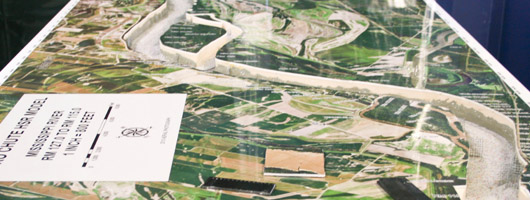
Model Calibration and Replication
The HSR modeling methodology employed a calibration process designed to replicate the general bathymetry and velocity distribution trends present in the river at the time of the model study. Replication of the model was achieved during calibration and involved a three step process.
First, planform “fixed” boundary conditions of the study reach, i.e. banks, islands, side channels, tributaries and other features were established according to the most recent available high resolution aerial photographs. Various other fixed boundaries were also introduced into the model. These included any channel improvement structures, underwater rock, clay formations, and other non-mobile boundaries.
Second, the “loose” boundary condition of the model was developed. Unconfined bed material was introduced into the channel throughout the model to an approximate level plane. The combination of the fixed and loose boundaries served as the starting condition of the model.
Third, steady state discharge simulation tests were run through the model. Discharge, sediment volume, model slope, fixed boundaries, and entrance conditions were refined during testing as part of model calibration. The model bathymetry developed from a static, flat bed into a fully-formed, dynamic, three dimensional bed response.
Repeated tests were performed for the assurance of model stability and repeatability. The resulting bed configuration was compared to recent river bathymetry surveys. When the general trends of the model bathymetry were similar to observed recent river bathymetry, and the tests were repeatable, the river was considered replicated by the model and alternative testing began.
Replication and Alternative Tests
Once replication was achieved through the calibration process, the resultant model bathymetry served as a benchmark for the comparison of all future model alternative tests. In this manner, the actions of any alternative, such as new channel improvement structures, realignments, side channel modifications, etc, were compared directly to the replication test. General trends were evaluated for any significant differences, either positive or negative, between the alternative and the replication by comparing the surveys of each, and also through careful observation of the model during testing.
